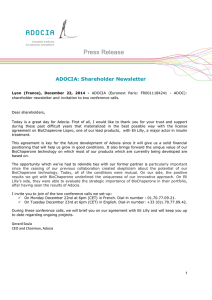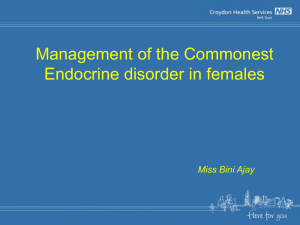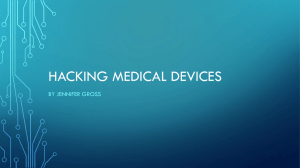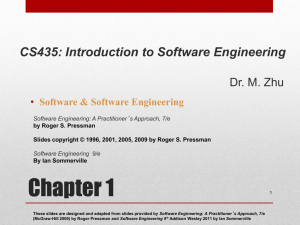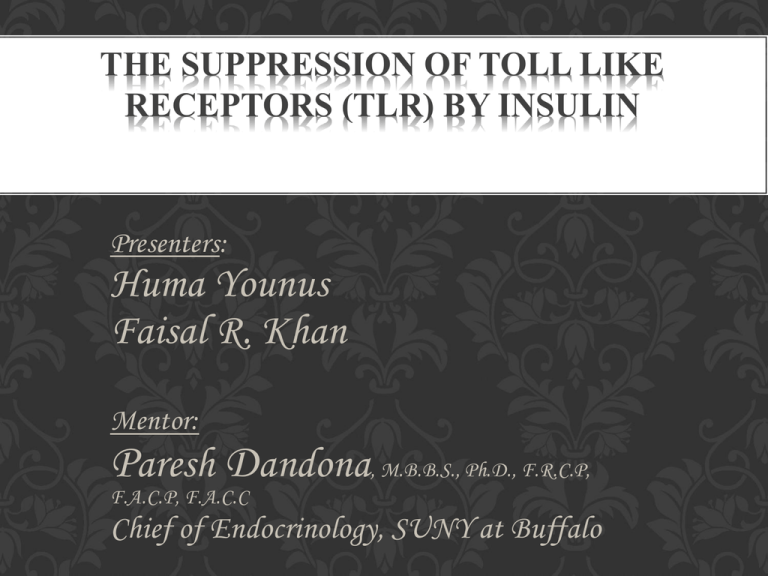
THE SUPPRESSION OF TOLL LIKE
RECEPTORS (TLR) BY INSULIN
Presenters:
Huma Younus
Faisal R. Khan
Mentor:
Paresh Dandona, M.B.B.S., Ph.D., F.R.C.P,
F.A.C.P, F.A.C.C
Chief of Endocrinology, SUNY at Buffalo
FAST FACTS … DIABETES MELLITUS
• Diabetes affects 25.8 million people of all
ages
• 8.3 percent of the U.S. population
• DIAGNOSED
18.8 million people
• UNDIAGNOSED
7.0 million people
CLINICAL QUESTION
• Type 2 Diabetes is caused by Insulin
resistance at cellular level…
1. How does that happen (basic
mechanism) ?
2. What pathways are involved?
3. Is there a way to reverse it?
1.Mechanism of Insulin
Resistance ... Role of
Innate Immune System
BACKGROUND..
INNATE IMMUNE SYSTEM
•
Consists of germline defense mechanisms
that are directed against molecular
components found only in microorganisms
•
The cardinal signs of inflammation i.e.
tumor, rubor, calor, and dolor are products
of the innate immune response
FUNCTIONS OF THE
INNATE IMMUNE SYSTEM
• Detection of microorganisms and first-line
defense against invasion and infection.
• Activation and instruction of adaptive
immune responses.
• Regulation of inflammation.
• Maintenance of “immunologic
homeostasis” within the host.
COMPONENTS OF INNATE IMMUNE SYSTEM
Three Main components:
1). Pathogen-Associated Molecular Patterns
(PAMPs): Various molecules that activate the
innate immune system.
2). Pattern Recognition Receptors(PRRs):
Recognize PAMPs( LPS etc.) and initiate the
inflammatory pathways.
3). Inflammatory cytokines.
PATHOGEN-ASSOCIATED MOLECULAR
PATTERNS (PAMPS)
•
A prototypical PAMP is bacterial endotoxin, or
lipopolysaccharide (LPS), which is a
component of the outer membrane of all
gram-negative bacteria.
•
Endotoxins contain Lipid A which interacts
with the toll-like receptors (PRRs).
Pattern Recognition Receptors
(PRRs)
•
Innate immune system recognizes
microbes through PRRs also known as
pathogen recognition receptors.
•
Expressed constitutively on many types of
innate immune cells and on the
professional antigen presenting cells
(macrophages, dendritic cells, monocytes,
and B lymphocytes).
•
Include TLRs, NLRs, RLRs.
TOLL LIKE RECEPTORS
• Structure.
• Distribution.
• Types.
STRUCTURE OF TLRS
All TLRs have:
• An extracellular ligand
recognition and binding
domain.
• A single trans-membrane
domain
• The cytoplasmic (signaling)
domain is homologous to the
interleukin-1 .
Variations in TLR ligands initiate
specific immunological
responses
CELLULAR DISTRIBUTION OF TLRS
Toll like receptors (TLR) are located on
macrophages, monocytes, neutrophils,
dendritic cells, mast cells, mucosal epithelial
cells and endothelial cells, all of which are
the mediators of innate immunity .
TYPES OF
TOLL LIKE RECEPTORS
TLR 2
• TLR2 is a cell surface receptor.
• Recognizes certain lipid moieties
derived from bacteria such as bacterial
lipoproteins and peptidoglycans.
• TLR2 might play a role in ischemiareperfusion induced myocardial injury.
TLR 4
• Similar to TLR 2 in distribution and
activation.
• TLR4 has also been shown to play an
important role in atherogenesis and
diet-induced obesity and related insulin
resistance
TLR 7 & 9
• TLR7 and TLR9 are endosomic
receptors, that recognizes single
stranded viral RNA (ssRNA) and
microbial DNA, respectively.
• Therefore, TLR7 and TLR9 modulate
adaptive immune responses including
autoimmunity against chromatin, e.g., in
systemic lupus erythematosus (SLE)
PATHWAYS INVOLVED AND ROLE
OF TOLL LIKE RECEPTORS IN
INFLAMMATORY CASCADE..
ACTIVATION OF TLR SIGNALING
• Activated by PAMPS.
• Cause transcriptional activation of
genes encoding for pro-inflammatory
cytokines, chemokines etc.
• Result in activation of antigen-specific
adaptive immune response
TLR ORGANIZATION AND SIGNALING PATHWAYS
•
IL-1 receptor associated kinases 1 and 4 (IRAK1, IRAK4).
•
Tumor necrosis factor receptor associated factor 6. TRAF 6
•
Transforming growth factor beta activated protein kinase 1 (TAK1)
•
Mitogen activated protein kinases (MAPKs).
SIGNALING
PATHWAYS
• All TLRs except TLR3 utilize myeloid differentiation
primary response protein 88 (MyD88).
• MyD88 adapter connects with various molecules
including IRAK, TRAF6, TAK.
• This complex kinase cascade culminates in activation
of broad array of genes influencing cell survival,
activation, and proliferation through AP-1 and NFkappa B
ROLL OF TLRS IN INFLAMMATION,
ATHEROSCLEROSIS AND IR
• Plasma concentration of LPS is significantly
increased in obese patients and is
significantly related to plasma insulin
concentration and HOMA-IR index of insulin
resistance, showing a link between LPS
concentration and insulin resistance.
• Human atherosclerotic plaques contain
endothelial cells and macrophages
expressing TLR1/2 and TLR4.
• High LPS concentrations can potentially lead
to TLR activation and induction of
inflammation leading to insulin resistance.
ROLL OF TLRS IN INFLAMMATION,
ATHEROSCLEROSIS AND IR
• Although the physiological reason for the
presence of these receptors is to
recognize pathogens and to trigger
immune mechanisms, their over
stimulation or abnormal responses could
easily mediate processes which could lead
to chronic or auto-immune inflammation.
3. WAYS TO REVERSE
INFLAMMATION AND INSULIN
RESISTANCE
EARLY 18TH CENTURY
• High doses of sodium salicylate (5.0–7.5 g/d)
were first demonstrated to diminish glycosuria
in diabetic patients having “the milder form of
the disease,” presumably type 2 diabetes.
• 1876 Ebstein concluded that sodium salicylate
could make the symptoms of diabetes mellitus
totally disappear. (1, 3).
HISTORICAL BACKGROUND
1957 Reid and colleagues found
• Insulin-treated diabetic, given high-dose aspirin to
treat the arthritis no longer required daily insulin
injections(4).
• Upon resolution of the joint symptoms, aspirin
was discontinued, and a repeat glucose tolerance
test was grossly abnormal.
MORE RECENTLY
• Increased levels of markers and mediators of
inflammation and acute-phase reactants such as
fibrinogen, C-reactive protein (CRP), IL-6,
plasminogen activator inhibitor-1 (PAI-1), sialic
acid, and white cell count correlate with incident
T2D.
• Adipose tissue–derived proinflammatory cytokines
such as TNF-α could actually cause insulin
resistance in experimental models .
OTHER OBSERVATIONS
• TNF-α, IL-6, MCP-1 etc produced by
adipose tissue as well as by mononuclear
cells(MNC).
• So Adipose tissue and MNC are the key cells
involved in producing the inflammatory
cytokines and inducing insulin resistance….
FACTORS AND MECHANISM OF OBESITY INDUCED
DM2 --THE “INFLAMMATION HYPOTHESIS”
. Obesity-induced chronic inflammation is a key
component in the pathogenesis of Insulin
resistance.
Pro-inflammatory cytokines can cause insulin
resistance (IR) in adipose tissue, skeletal
muscle and liver by inhibiting insulin signal
transduction.
Positive correlation between BMI and plasma TNFα
concentrations.
However, the exact mechanism is still poorly
understood
PATHWAYS… OVERVIEW
• Two major pathways
• JNK and IKKβ pathways, involving
cytokines and TLRs.
Stimuli that have been shown to activate these pathways during metabolic dysregulation include ligands for
TNF-α, IL-1, Toll, or AGE receptors (TNFR, IL-1R, TLR, or RAGE, respectively). Obesity-induced IKKβ activation
leads to NF-κB translocation and the increased expression of numerous markers and potential mediators of
inflammation that can cause insulin resistance. Obesity-induced JNK activation promotes the phosphorylation of
IRS-1 at serine sites that negatively regulate normal signaling through the insulin receptor/IRS-1 axis.
Examples include serine-302 (pS302) and serine-307 (pS307).
HYPOTHESIS
• First controlled trial to investigate the effect of insulin
on the expression of TLR in the peripheral blood
mononuclear cells (MNC) and adipose tissue of obese
and Type 2 diabetes mellitus subjects.
• The central hypothesis of this application was that insulin
will suppress the expression of TLR2, TLR4, TLR7 and
TLR9 at the mRNA and protein levels in MNC and
adipose tissue of obese and type 2 diabetic subjects.
Thank You.. Please stay tuned for the second part of
presentation…
Clinical trial and results
CHALLENGES
• What came first ? Obesity or Diabetes (chicken or egg)?
• Prove that obesity induces resistance.
• Why do Type 2 diabetics improve with insulin if they are
not deficient in it???
• Why do they require huge amounts of insulin??
• When should Insulin be started?? Should we wait for
their pancreas to totally fail before we do it?
• Why Why Why………. Why did I even take this project!!
STUDY DESIGN
Double blinded, cross-over and controlled
prospective study.
A total of 60 subjects divided into 20 lean, 20
obese and 20 obese type 2 diabetic (DM)
subjects were enrolled.
Fasting blood samples and fat biopsies were
collected from all subjects to compare basal
TLR expression between the groups.
EXPERIMENTAL METHOD
• Insulin/dextrose/potassium regimen at 3 different doses
of insulin (2, 3.5 and 5 U/hr) were given to obese and
diabetic subjects in the experimental arm followed by
the control arm where 3 infusions with
dextrose/potassium regimen only in quantities similar to
those infused with each of the 3 insulin doses and a
normal physiological saline infusion was given .
• Dextrose infusion rate was titrated to maintain blood
glucose concentration at target levels within 10mg of the
baseline glucose concentration (usually 80-120 mg/dl).
EXPERIMENTAL METHOD
• Potassium Chloride was co-infused to prevent
hypokalemia and was monitored every 2 hourly
during all insulin infusions.
• Blood samples (30 ml/time point for a total of 210
ml/visit) were drawn at Baseline, 2, 4, 8 and 14
hours following the start of the infusions.
• Fat biopsy samples were taken at three separate
visits, for a total of six fat biopsies one in the
fasting stage and one at 12 hours.
INCLUSION CRITERIA
• Lean Group:1)Age: 20 to 65 years 2) Sex: male or female
3)Normal fasting plasma glucose (65-100 mg/dl),
4)Normal BMI (20-25).
• Obese Group:1)Age: 20 to 65 years 2) Sex: male or
female 3)Normal fasting plasma glucose (65-100 mg/dl),
4)BMI> 30.
• DM Group: 1)Type 2 Diabetes Mellitus 2)Age: 20 to 65
years 3)Sex: male or female 4)BMI >30 5)Hba1c < 8%
6)If on statins, angiotensin converting enzyme inhibitor,
angiotensin receptor blocker or low dose aspirin, should
be on a stable dose for one month.
EXCLUSION CRITERIA
• Pregnancy
• Congestive heart failure.
• Heart Rate <50 beats /minute , Sick Sinus
Syndrome , Second or third degree heart block.
• Blood pressure <80 mm systolic or > 160/100
mmHg
• Coronary event or procedure (myocardial
infarction, unstable angina, coronary artery bypass
surgery or coronary angioplasty) in the previous
three months 8)Hepatic disease (transaminase > 3
times normal)
• Renal impairment (serum creatinine > 1.5)
EXCLUSION CRITERIA
• Participation in any other concurrent clinical trial
• Potassium (K+) values <3.5 meq/l to > 5.5 meq/l)
• Use of an investigational agent or therapeutic regimen
within 30 days of study
• Type 2 diabetics on thiazolidinediones and/ or insulin
• Subjects on steroids, NSAIDS or antioxidants
• Patients taking exenatide or sitaglipin or loop diuretics.
• Anemia (Hemoglobin level less than 12gm/dl in females
and 13gm/dl in males).
• Any other life-threatening, non-cardiac disease.
LABORATORY PROCEDURES
• MNC isolation by Ficoll-hypaque method.
This method provides yields greater than
95% pure PMN and MNC suspensions.
• Quantification of TLRs (2, 4, 7 and 9)
mRNA in MNC and adipose tissue by
RT-PCR.
1. What came first…..
2. Prove obesity causes insulin resistance….
TLR expression in Obese as compared to lean
subjects.
RESULTS: 1
TLR EXPRESSION IN ADIPOSE TISSUE
FROM LEAN AND OBESE SUBJECTS
• Fat aspiration was performed lean BMI: 22.8±1.9
and obese BMI: 35.6±5.1 subjects following an
overnight fast.
• The mRNA expression of TLR2, TLR4, TLR7 and
TLR9 were measured by real time RT-PCR.
• There were no significant statistical differences in
baseline characteristics between the two groups.
1.75
120
LEAN
OBESE
LEAN
OBESE
TLR2 protien in Adipose Tissue
(Arbitrary Units)
mRNA Expression in Adipose Tissue
(Arbitrary Units)
2.00
1.50
1.25
1.00
0.75
0.50
0.25
*
100
80
60
40
20
0.00
TRL2
A
TLR4
TLR7
TLR9
0
B
TLRs in adipose tissue from obese and lean subjects. A) TLR2, TLR4, TLR7 and
TLR9 mRNA expression in Adipose tissue of obese and lean subjects. B) TLR-2
protein expression in adipose tissue from obese and lean subjects (n=8 vs. 8)
*= P<0.05, t-test.
What happens to TLRs after a high fat high
carbohydrate(HFHC) meal in lean subjects.
RESULTS: 2
EFFECT OF HIGH FAT HIGH CARBOHYDRATE (HFHC) MEAL
ON TLR4 EXPRESSION AND PLASMA ENDOTOXIN
CONCENTRATIONS
• Four groups (10-12 each) of healthy lean
subjects were given either 300 Calories of
glucose, 300 Calories of dairy cream, 900
Calories HFHC meal or water to ingest
following an overnight fast.
% Change in TLR4 mRNA Expression in MNC
160
Water
Glucose
Cream
Meal
150
140
+$
*
+$
*#
*#
130
120
110
100
90
80
0
1
2
3
% change in TLR4 protein levels in MNC
Hours After Challenge
Water
Glucose
Cream
Meal
165
150
*#
+$
#
2
3
*#
135
120
105
90
75
0
1
Hours After Challenge
TLR4 mRNA (A) and protein (B) expression in MNC following glucose, cream and meal intake compared to
water intake in normal healthy subjects. *= P<0.05 by RMANOVA compared to baseline following cream
challenge; #= P<0.05 by two-way ANOVA comparing cream and water groups; += P<0.05 by RMANOVA
compared to baseline following meal challenge and $=P<0.05 by two-way ANOVA comparing meal and
water groups.
% change in Plasma EndotoxinConcentrations
220
Water
Glucose
Cream
Meal
200
180
*#
*#
160
140
120
100
80
60
0
1
2
3
HOURS
Percent change in Plasma Endotoxin concentrations following glucose, cream and
meal intake compared to water intake in normal healthy subjects. *= P<0.05 by
RMANOVA compared to baseline following cream challenge; #= P<0.05 by two-way
ANOVA comparing cream and water groups
INFERENCES
• There is an acute elevation of plasma endotoxin
levels following a high fat and/or high
carbohydrate (HFHC) meal.
• There is increased expression of TLR mRNA
and proteins following HFHC meal.
• Since TLR are activated by endotoxins, elevated
endotoxin levels can stimulate TLRs and initiate
an inflammatory response.
ANSWERS
1. No one knows what came first…but if
you are overweight , Diabetes is certainly
coming.
2. Obesity causes resistance by activating
inflammation. Watch what you eat. It’s a
good idea to cut the cream in your Double
Double coffee.
1. Why do Type 2 diabetics improve with insulin if they
are not deficient in it???
2. Why do they require huge amounts of insulin??
3. When should Insulin be started?? Should we wait for
their pancreas to totally fail before we do it?
Lets give Insulin and see !!!!
Effect of Insulin on Toll Like Receptors in Obese and Diabetic
groups
RESULTS: 3
% Change in TLR2 mRNA
Expression
160
Insulin
Dextrose
Saline
140
120
100
80
*#
*
60
0
2
4
6
Hours
Insulin
Dextrose
Saline
% Change in TLR4 mRNA
Expression
140
120
100
80
60
*#
*#
40
0
2
4
6
Hours
Figure 1: TLRs mRNA expression by RT-PCR following insulin, dextrose or saline infusion in DM subjects. A) TLR2, B)
TLR4 mRNA expression in MNC of DM subjects following 2unit/hour insulin infusion compared to dextrose infusion control.
*= P<0.05, RMANOVA compared to baseline and # P<0.05, 2-way RMANOVA compared to control groups.
Insulin
Dextrose
Saline
% Change in TLR7 mRNA
Expression
140
120
100
80
60
*#
*#
40
0
2
4
6
Hours
Insulin
Dextrose
Saline
% Change in TLR9 mRNA
Expression
140
120
100
80
60
*#
*#
2
4
40
0
6
Hours
Figure 2: TLRs mRNA expression by RT-PCR following insulin, dextrose or saline infusion in DM subjects.
A) TLR7 and B) TLR9 mRNA expression in MNC of DM subjects following 2unit/hour insulin infusion compared to dextrose
infusion control. *= P<0.05, RMANOVA compared to baseline and # P<0.05, 2-way RMANOVA compared to control groups.
Effect of Low Dose Insulin infusion on TLR4 mRNA in MNC in Obese
subjects
Change in TLR4
mRNA Expression in MNC (%)
120
Dextrose
Insulin
Saline
110
100
90
80
*#
*#
70
0
2
4
8
14
16
Hours following Infusion
* P < 0.05 by One Way RM ANOVA
# P < 0.05 by Two Way RM ANOVA
Effect of Low Dose Insulin infusion on TLR4 protein in MNC in Obese
subjects
Change in TLR4
Protein Expression in MNC (%)
120
Dextrose
Insulin
110
100
90
80
70
*#
60
0
2
4
8
14
16
Hours following Infusion
* P < 0.05 by One Way RM ANOVA
# P < 0.05 by Two Way RM ANOVA
INFERENCES
• Insulin suppresses the mRNA expression of
TLR2, 4, 7 and 9 from MNC within 2 hours
of the commencement of insulin infusion
with a maximum fall at 4 hours.
.
INSULIN AS INSULIN SENSITIZER
• It is hypothesized that through its antiinflammatory effects insulin possibly acts as
a self sensitizer.
• This can be explained on the basis of the
fact that insulin signaling and serine kinase
inflammatory pathway intersect at IRS
(Insulin receptor signaling) molecule level.
Common
target
Figure: Insulin-receptor signaling interfaces with inflammatory signaling at the level of
insulin-receptor substrates through activation of serine kinases. These kinases respond
to both lipids and cytokines. Both IRS-1 and IRS-2 contain a number of serine residues
(indicated by white stars) that are targeted by various kinases, which have been more
extensively mapped for IRS-1 (ref. 50). All of the molecules listed that regulate insulin
action in response to inflammatory signals converge on IRS-1.
Change in P38 Protein in MNC (%)
Effect of Low Dose Insulin infusion on p38 protein in MNC in Obese (Upper)
and T2DM(Lower) subjects.
130
120
Dextrose
Insulin
Saline
110
100
90
80
70
*
60
0
2
4
8
14
16
Change in P38 Protein in MNC (%)
Hours following Infusion
120
Dextrose
Insulin
Saline
110
100
90
80
*#
70
0
2
4
8
14
Hours following Infusion
16
Change in PTP-1B Protein in MNC (%)
Effect of Low Dose Insulin infusion on PTP-1B protein in MNC in Obese and
T2DM subjects
130
120
Dextrose
Insulin
Saline
110
100
90
80
70
*#
*
60
0
2
4
8
14
16
Change in PTP-1B Protein in MNC (%)
Hours following Infusion
130
120
Dextrose
Insulin
Saline
110
100
90
80
70
*#
*
60
0
2
4
8
14
Hours following Infusion
16
Change in JNK-1 Protein in MNC (%)
Effect of Low Dose Insulin infusion on JNK-1 protein in MNC in Obese and
T2DM subjects
130
120
Dextrose
Insulin
Saline
110
100
90
80
70
*#
*#
60
0
2
4
8
14
16
Change in JNK-1 Protein in MNC (%)
Hours following Infusion
130
Dextrose
Insulin
Saline
120
110
100
90
80
*#
70
60
0
2
4
8
14
Hours following Infusion
16
Effect of Low Dose Insulin infusion on PKC- II mRNA in Adipose Tissue
and MNC in Obese subjects
0hr
14 hr
120
% Change
100
80
*#
60
40
20
0
Insulin
Dextrose
Saline
PKC- II mRNA- Adipose tissue
Change in PKC-II
mRNA Expression in MNC (%)
120
Dextrose
Insulin
Saline
110
100
90
80
*#
*#
70
0
2
4
8
14
Hours following Infusion
16
Effect of Low Dose Insulin infusion on IKK- mRNA in
Adipose Tissue in Obese subjects
120
0hr
14 hr
% Change
100
80
*#
60
40
20
0
Insulin
Dextrose
Saline
IKK- mRNA- Adipose tissue
WHAT DOES ALL THIS FANCY DATA
TRANSLATE INTO ????
ANSWERS
1. Why do Type 2 diabetics improve with insulin if
they are not deficient in it???
2. Why do they require huge amounts of insulin??
• Insulin has the power to overcome the serine
kinase induced inflammatory and insulin
resistance cascade probably by competitive
activation of IRS.
When should Insulin be started?? Should we wait
for their pancreas to totally fail before we do it?
3.
• Early insulin administration in Obese with
metabolic syndrome and type 2 diabetes patients
may overcome the resistance and provide better
glycemic control than oral hypoglycemics alone.
REFERENCES
1. Ebstein W. Zur therapie des Diabetes mellitus, insbesondere über die Anwendung des salicylsauren Natron bei
demselben. Berliner Klinische Wochenschrift. 1876;13:337–340.
2. Williamson R.T. On the treatment of glycosuria and diabetes mellitus with sodium salicylate. Br. Med. J.
1901;1:760–762.
3. Shoelson S. Invited comment on W. Ebstein: on the therapy of diabetes mellitus, in particular on the application of
sodium salicylate. J. Mol. Med. 2002;80:618–619.[PubMed]
4. Reid J., Macdougall A.I., Andrews M.M. On the efficacy of salicylate in treating diabetes mellitus. Br. Med. J.
1957;2:1071–1074. [PMC free article][PubMed]
5. Hecht A., Goldner M.G. Reappraisal of the hypoglycemic action of acetylsalicylate. Metabolism. 1959;8:418 –
428.[PubMed]
6. Gilgore S.G. The influence of salicylate on hyperglycemia. Diabetes. 1960;9:392 –393.
7. Baron S.H. Salicylates as hypoglycemic agents. Diabetes Care. 1982;5:64 –71.[PubMed]
8. Yuan M., et al. Reversal of obesity- and diet-induced insulin resistance with salicylates or targeted disruption
ofIkkβ. . Science. 2001;293:1673–1677.[PubMed]
9. Hundal R.S., et al. Mechanism by which high-dose aspirin improves glucose metabolism in type 2 diabetes. J. Clin.
Invest. 2002;109:1321–1326. doi: 10.1172/JCI200214955. [PMC free article][PubMed] [Cross Ref]
10. Shoelson S.E., Lee J., Yuan M. Inflammation and the IKKβ/IκB/NF-κB axis in obesity- and diet-induced insulin
resistance. Int. J. Obes. Relat. Metab. Disord. 2003;27(Suppl. 3):S49–S52.[PubMed]
THANK YOU FOR YOUR TIME…





